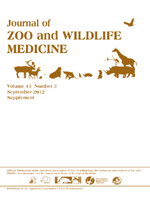Although excessive iron storage in black rhinoceros (Diceros bicornis) has been a cause for continuous concern over the last four decades and differences in the iron content of diet items fed in captivity and in the wild have been documented, no reports exist on the iron content of the total diet ingested by free-ranging animals. Here, the results of field studies using backtracking to record the ingested diets of black rhinoceros from three habitats across three seasons are reported. Levels of iron and of condensed tannins, which might reduce iron availability, averaged at 91 ± 41 ppm dry matter and 3.0 ± 1.0% dry matter, respectively, across all habitats and seasons. Although geographic and seasonal variation was significant, these differences are of a much lower magnitude than differences between the averages of these diets and those fed to black rhinoceros in captivity. The results can provide guidelines for the iron content of diets designed for black rhinoceros and suggest that the effect of tannins in these species should be further investigated.
How to translate text using browser tools
2 September 2012
BLACK RHINOCEROS (DICEROS BICORNIS) NATURAL DIETS: COMPARING IRON LEVELS ACROSS SEASONS AND GEOGRAPHICAL LOCATIONS
Stephane F. Helary,
Joanne A. Shaw,
Derek Brown,
Marcus Clauss,
Norman Owen-Smith
ACCESS THE FULL ARTICLE
black rhinoceros
hemosiderosis
iron
natural diet
tannin





